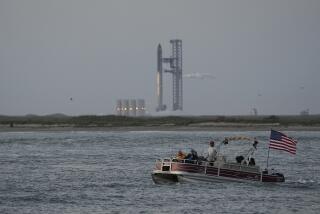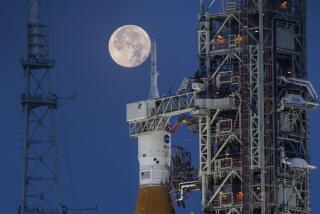NASA unveils space vehicle with a stitched-together look
After more than a yearâs delay, NASA on Wednesday unveiled its plan to build a heavy launch vehicle capable of sending astronauts beyond low-Earth orbit by 2025, but it would be only slightly more powerful than the 1960s-era Saturn V that launched Americans to the moon.
The new system would combine elements of the retired space shuttle, the abandoned Constellation program and some potentially new hardware that would be phased in over the next decade, assuming Congress continues to provide about $3 billion per year for the work.
Although NASA has outlined its engineering design for the launch system, the agency has not yet set out a road map of where the machine would take humans in the solar system and when exactly it would conduct such missions.
NASA officials have discussed a trip to circle the moon without landing, a trip to an asteroid and an eventual journey to Mars. But those discussions are far from a concrete plan with a well-defined schedule.
âThere has been no articulation of a vision or direction, and that has left our international partners wondering where we are headed,â said Scott Pace, director of the space policy institute at George Washington University, who has served at NASA and the White House. âThe other shoe still has to drop. We still donât have a space policy.â
But industry officials were relieved that NASA had finally made a hardware decision.
âFirst and foremost, it is a decision and for us that is a big deal,â said Jim Maser, president of Pratt & Whitney Rocketdyne, the engine manufacturer that would supply both the first- and second-stage liquid hydrogen rockets. âWe want to go as fast as we possibly can.â
The Canoga Park operation has lost 300 employees because of the space shuttle retirement. Its workforce now stands at 1,500.
The new launch vehicle, dubbed blandly the Space Launch System, would consist of a first stage that uses up to five space shuttle main engines. NASA still has about 10 to 15 of those engines in its warehouse, so initially that would help save money. Later, Rocketdyne would supply a new, expendable version of the engine, which remains the most efficient liquid rocket engine ever designed.
The new system would use a solid rocket booster derived from the space shuttle, but with five segments of fuel rather than the four used on the shuttle. The second stage would use a J-2x hydrogen engine derived from the Saturn program.
The stack of rockets would loft the Orion crew capsule, which could carry up to six astronauts. That capsule is now under construction at Lockheed Martin Corp.
William H. Gerstenmaier, NASAâs associate administrator for space operations, said that the rocket would make its first unmanned flight in 2017. The first launch would achieve only half of the intended lifting capacity of the system into low-Earth orbit, which is 130 metric tons.
By contrast, the Saturn system could send 119 metric tons to low-Earth orbit or 45 tons to the moon.
Pace said the new system should have been designed to lift 150 metric tons, although the space agency can make do with the lower lift. But Pace asserted that NASAâs decision to use existing shuttle engines will drive up costs in the long run, compared with an earlier plan to use the RS-68 hydrogen engine that is already in production for Boeingâs Delta launch vehicle.
Other analysts were similarly unimpressed.
Marco A. Caceres, space analyst for the aerospace research firm Teal Group Corp. of Fairfax, Va., said there was little about the rocket to generate excitement.
âThereâs nothing new here,â he said, comparing it to the Constellation program. âTheyâre repackaging the same old product that was canceled because of cost overruns and a lack of a defined mission and trying to sell it to the taxpayer again.â
Caceres said there was a lack of detail about the most difficult aspects of the exploration mission. Wednesdayâs announcement, he said, was simply a ruse to fill the void of the retired space shuttle fleet and a trick to make Americans feel as though theyâre in the space race again.
âNASAâs not aiming to develop any cutting-edge technology here,â he said. âThis is a jobs program, pure and simple. A lot of engineers have lost their jobs. This program appears to address that.â
--
More to Read
Sign up for Essential California
The most important California stories and recommendations in your inbox every morning.
You may occasionally receive promotional content from the Los Angeles Times.











